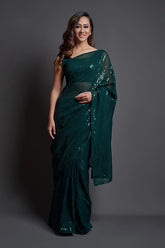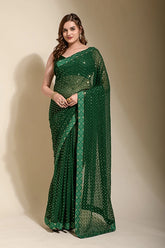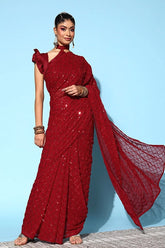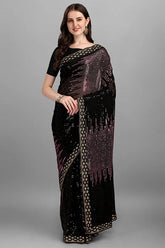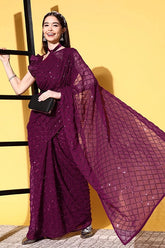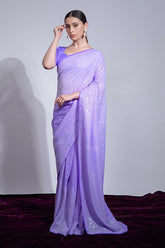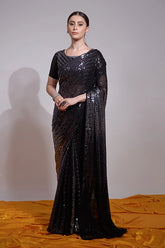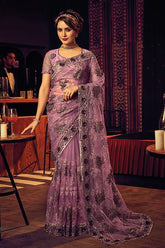- 10
- 15
- 20
- 25
- 30
- 50
- Featured
- Best selling
- Alphabetically, A-Z
- Alphabetically, Z-A
- Price, low to high
- Price, high to low
- Date, old to new
- Date, new to old
Sort by:
- Featured
- Best selling
- Alphabetically, A-Z
- Alphabetically, Z-A
- Price, low to high
- Price, high to low
- Date, old to new
- Date, new to old
-
Vendor:SHUBHKALA
Stunning Black Georgette Saree with Cutwork Lace
Stunning Black Georgette Saree with Cutwork Lace Elevate your ethnic wardrobe with this stunning Black Georgette Saree with Cutwork Lace Design, a perfect blend of elegance and sophistication. Crafted from premium georgette fabric, this saree undoubtedly makes a statement at weddings, festive gatherings, and...- Rs. 1,699.00
- Rs. 1,699.00
Rs. 3,399.00- Unit price
- / per
(50% Off)No reviews -
Vendor:SHUBHKALA
Bollywood Designer Grey Georgette Silk Saree Online
Unveil Elegance with the Bollywood Designer Grey Heavy Georgette Silk Saree The Bollywood Designer Grey Heavy Georgette Silk Saree is a Timeless Piece Designed for Women Who Love to Exude Grace and Sophistication. Crafted From Pure Heavy Georgette Silk Fabric, It Boasts a Lightweight...- Rs. 1,499.00
- Rs. 1,499.00
Rs. 2,999.00- Unit price
- / per
(50% Off)No reviews -
Vendor:SHUBHKALA
Stylish Pink Georgette Saree with Swarovski Work
Elevate Your Style with a Stylish Pink Georgette Saree Transform Your Look for Any Special Occasion With This Pink Georgette Saree With Swarovski Work. Crafted From Heavy Soft Georgette Fabric, It Offers a Luxurious Feel and an Effortlessly Elegant Drape. The Entire Saree is...- Rs. 1,699.00
- Rs. 1,699.00
Rs. 3,399.00- Unit price
- / per
(50% Off)No reviews -
Vendor:SHUBHKALA
Green Bollywood Designer Saree with Embroidery Work
Elevate Your Ethnic Look with Our Green Bollywood Designer Saree If You Are Looking to Make a Lasting Impression at a Festive Gathering, Wedding, or Special Occasion, This Green Bollywood Designer Saree is the Ultimate Choice. the Complementary Blouse Fabric is Also Crafted From...- Rs. 1,499.00
- Rs. 1,499.00
Rs. 2,999.00- Unit price
- / per
(50% Off)No reviews -
Vendor:SHUBHKALA
Beautiful Embroidered Green Georgette Saree Online
Elevate Your Wardrobe with the Beautiful Embroidered Green Georgette Saree Add a Touch of Elegance to Your Festive Wardrobe With This Stunning Chokdi Pattern Georgette Saree. Made From Premium-quality Heavy Soft Georgette Fabric, This Saree is Designed to Make You the Center of Attention....- Rs. 1,699.00
- Rs. 1,699.00
Rs. 3,399.00- Unit price
- / per
(50% Off)No reviews -
Vendor:SHUBHKALA
Designer Chokdi Embroidery Georgette Saree in Blue
Elegance Redefined with Embroidery Georgette Saree Step into a world of elegance with this Embroidery Saree in a stunning blue hue. Crafted from soft, heavy georgette fabric, this saree exudes sophistication and style. It is perfect for festive occasions, weddings, and special events. The...- Rs. 1,699.00
- Rs. 1,699.00
Rs. 3,399.00- Unit price
- / per
(50% Off)No reviews -
Vendor:SHUBHKALA
Blue Georgette Silk Saree with Embroidery Work
Elevate Your Look with the Blue Embroidered Georgette Silk Saree The Blue Saree With Embroidery Work is a Timeless Addition to Your Wardrobe. It Combines Elegance, Tradition, and Contemporary Design. Heavy Georgette Saree in Blue , This Blue Saree with Piping Border The Luxurious...- Rs. 1,499.00
- Rs. 1,499.00
Rs. 2,999.00- Unit price
- / per
(50% Off)No reviews -
Vendor:SHUBHKALA
Stylish Maroon Saree with Butti Work Border
Elevate Your Style with the Stylish Maroon Saree with Butti Work When Elegance Meets Tradition, It Creates a Masterpiece Like Our Stylish Maroon Saree With Butti Work. Crafted to Perfection With Premium Georgette Fabric, This Exquisite Saree Offers a Smooth and Lightweight Drape. Whether...- Rs. 1,699.00
- Rs. 1,699.00
Rs. 3,399.00- Unit price
- / per
(50% Off)No reviews -
Vendor:SHUBHKALA
Bollywood Designer Black Georgette Silk Saree Online
Bollywood Designer Black Georgette Silk Saree – A Timeless Elegance Elevate Your Ethnic Wardrobe With This Stunning Bollywood Designer Black Georgette Silk Saree, a True Masterpiece That Seamlessly Blends Traditional Craftsmanship With Contemporary Style. Perfect for Festivals, Weddings, and Parties, This Saree Exudes Charm...- Rs. 1,499.00
- Rs. 1,499.00
Rs. 2,999.00- Unit price
- / per
(50% Off)No reviews -
Vendor:SHUBHKALA
Navy Blue Designer Saree with Sequins Border
Elevate Your Style with the Navy Blue Designer Saree Step Into a World of Elegance With Our Navy Blue Designer Saree, Crafted for Modern Women Who Love to Designer Saree with Sequins Border . This Stunning Saree Features Intricate Butti Work on Luxurious Georgette...- Rs. 1,699.00
- Rs. 1,699.00
Rs. 3,399.00- Unit price
- / per
(50% Off)No reviews -
Vendor:SHUBHKALA
Buy Red Bollywood Designer Georgette Saree Online
Bollywood Designer Fancy Red Saree Online This Gorgeous Fancy Red Saree Online Embroidery in a Double Run. It Blends Modern Glamour With Traditional Aesthetics. Made From Designer Red Georgette Saree , It Drapes Effortlessly and Offers Both Comfort and Style. It’s Perfect for Weddings,...- Rs. 1,599.00
- Rs. 1,599.00
Rs. 3,199.00- Unit price
- / per
(50% Off)No reviews -
Vendor:SHUBHKALA
Dark Green Georgette Saree with Sequin Border
Festive Heavy Georgette Saree – A Masterpiece of Elegance Discover Elegance and Style With This Stunning Heavy Georgette Saree with Sequins Designed to Make a Statement at Every Festive Occasion. It Beautifully Combines Timeless Tradition With a Contemporary Touch. Featuring Intricate Multi-color Zigzag Sequin...- Rs. 1,699.00
- Rs. 1,699.00
Rs. 3,399.00- Unit price
- / per
(50% Off)No reviews -
Vendor:SHUBHKALA
Bollywood Style Pista Green Georgette Saree Online
Bollywood Georgette Saree Online The Bollywood Style Pista Green Georgette Saree is a perfect blend of elegance and glamour. Made from premium-quality georgette fabric, Bollywood Georgette Saree Online work in double-run style, offering a sophisticated look suitable for various occasions. Its pista green color...- Rs. 1,599.00
- Rs. 1,599.00
Rs. 3,199.00- Unit price
- / per
(50% Off)No reviews -
Vendor:SHUBHKALA
Heavy Sequence Work Georgette Saree - Pink
Elegant Heavy Sequence Work Georgette Saree for Women The Heavy Sequence Work Georgette Saree is a timeless masterpiece that embodies elegance and sophistication. Crafted from premium georgette fabric, this saree is adorned with intricate sequins embroidery done in a double-run style, making it a...- Rs. 1,599.00
- Rs. 1,599.00
Rs. 3,199.00- Unit price
- / per
(50% Off)No reviews -
Vendor:SHUBHKALA
Stylish Red Georgette Saree for Weddings – Shop Online
Stylish Red Wedding Georgette Saree Online Discover elegance and grace with our , a perfect choice for weddings and special occasions. Made from premium georgette fabric, this saree features intricate sequence embroidery work that adds a touch of glamour to your look.Red Bridal Georgette...- Rs. 1,499.00
- Rs. 1,499.00
Rs. 2,999.00- Unit price
- / per
(50% Off)No reviews -
Vendor:SHUBHKALA
Designer Petrol Georgette Saree with Sequence Work
Embrace Elegance with the Designer Petrol Georgette Saree Step Into a World of Elegance and Sophistication With Our Designer Petrol Georgette Saree With Sequence Work. This Stunning Georgette Elegance Saree for Women, Making It a Must-have Addition to Your Wardrobe. Whether You're Attending a...- Rs. 1,599.00
- Rs. 1,599.00
Rs. 3,199.00- Unit price
- / per
(50% Off)No reviews -
Vendor:SHUBHKALA
Stylish Petrol Georgette Saree for Weddings
Stylish Petrol Georgette Wedding Saree & Blouse Elevate Your Style This Wedding Season With This Beautiful Saree, Perfect for Anyone Looking to Make a Memorable Impression. Made From Premium Georgette Wedding Saree & Blouse It Has a Lightweight Yet Luxurious Feel, Making It Great for...- Rs. 1,499.00
- Rs. 1,499.00
Rs. 2,999.00- Unit price
- / per
(50% Off)No reviews -
Vendor:SHUBHKALA
Heavy Designer Onion Shade Saree with Sequence Work
Stunning Heavy Designer Saree in Onion Shade Looking for a Saree That Exudes Elegance and Sophistication? Our Heavy Designer Saree in Onion Shade With Sequence Work is the Perfect Choice for Weddings, Parties, and Festive Occasions. Crafted From Premium Georgette Fabric, This Heavy Designer...- Rs. 1,599.00
- Rs. 1,599.00
Rs. 3,199.00- Unit price
- / per
(50% Off)No reviews -
Vendor:SHUBHKALA
Stylish Sequence Embroidery Black Georgette Saree
Unveil Timeless Elegance with the Stylish Sequence Embroidery Black Georgette Saree The Stylish Sequence Embroidery Black Georgette Saree combines timeless elegance with modern style. Made from high-quality georgette fabric, this saree exudes sophistication and grace. The black color suits all skin tones and occasions,...- Rs. 1,499.00
- Rs. 1,499.00
Rs. 2,999.00- Unit price
- / per
(50% Off)No reviews -
Vendor:SHUBHKALA
Golden Georgette Saree with Two-Tone Sequins Work
Experience Elegance with the Golden Georgette Saree with Sequins Work The Golden Georgette Saree With Two-tone Sequins Work is a Timeless Piece That Georgette Saree Fancy Embroidery Perfect for Weddings, Festive Occasions, and Glamorous Evening Events. This Saree Showcases Exquisite Craftsmanship With Its Beautiful...- Rs. 1,599.00
- Rs. 1,599.00
Rs. 3,199.00- Unit price
- / per
(50% Off)No reviews -
Vendor:SHUBHKALA
Designer Wine Saree & Blouse for Weddings & Parties
Unveil Elegance with Our Designer Wine Saree Looking for a stunning outfit that grabs attention at weddings and parties? Our Designer Wine Saree with Sequin Embroidery is the perfect choice for women who love elegance and style. Made from high-quality Georgette Saree with sequin...- Rs. 1,499.00
- Rs. 1,499.00
Rs. 2,999.00- Unit price
- / per
(50% Off)No reviews -
Vendor:SHUBHKALA
Georgette Saree with Stunning Sequence Embroidery Work
Onion Color Georgette Saree with Sequence Embroidery Work Elevate your wardrobe with this , a stunning blend of elegance and modern design. The saree features intricate sequence embroidery work, making it perfect for occasions where you want to make a bold statement. The lightweight,...- Rs. 1,499.00
- Rs. 1,499.00
Rs. 2,999.00- Unit price
- / per
(50% Off)No reviews -
Vendor:SHUBHKALA
Purple Designer Saree with Sequins Embroidery
Elevate Your Style with Our Purple Designer Saree Step Into the Spotlight With This Designer Purple Saree Online Saree, Featuring Fancy Sequins Embroidery on Heavy Georgette Fabric. This Designer Purple Saree Online Traditional Elegance With a Modern Touch, Making It the Perfect Choice for...- Rs. 1,699.00
- Rs. 1,699.00
Rs. 3,399.00- Unit price
- / per
(50% Off)No reviews -
Vendor:SHUBHKALA
Heavy Georgette Pink Saree with Fancy Sequins Work
INTRODUCTION ABOUT SAREE & BLOUSE Experience timeless elegance with our Heavy Georgette Pink Saree, crafted from premium georgette fabric to exude luxury and sophistication. This saree is adorned with intricate fancy sequins embroidery work in a double-run design, making it a perfect pick for...- Rs. 1,699.00
- Rs. 1,699.00
Rs. 3,399.00- Unit price
- / per
(50% Off)No reviews -
Vendor:SHUBHKALA
Wedding Georgette Saree with Sequin Flower Design
Elegant Wedding Georgette Saree with 4-Type Sequin Flowers Introducing a masterpiece in bridal fashion, the Wedding Georgette Heavy Georgette Saree for Weddings to make every moment unforgettable. Crafted with precision from heavy georgette fabric, this saree features exquisite multi-color, 4-type sequin flower work, adding...- Rs. 1,599.00
- Rs. 1,599.00
Rs. 3,199.00- Unit price
- / per
(50% Off)No reviews -
Vendor:SHUBHKALA
Lightweight Premium Georgette Saree Online
Elevate Your Style with the Lightweight Premium Georgette Saree Experience elegance and comfort with our Lightweight Premium Georgette Saree, a perfect blend of contemporary design and timeless appeal. Designed for women who want to make a statement, this saree offers both style and ease....- Rs. 1,799.00
- Rs. 1,799.00
Rs. 3,599.00- Unit price
- / per
(50% Off)No reviews -
Vendor:SHUBHKALA
Heavy Georgette Saree with Multicolor Sequence Embroidery
A Stunning Blend of Elegance and Style: Heavy Georgette Saree Enhance Your Festive and Wedding Wardrobe With Our Heavy Georgette Saree, Beautifully Decorated With Multicolor Sequence Embroidery. This Stunning Saree Combines Style and Craftsmanship, Making It the Ideal Choice for Women Who Want to...- Rs. 1,799.00
- Rs. 1,799.00
Rs. 3,599.00- Unit price
- / per
(50% Off)No reviews -
Vendor:SHUBHKALA
Buy Bollywood Designer Georgette Saree Online
INTRODUCTION ABOUT SAREE & BLOUSE Introducing Our Bollywood Designer Georgette Saree in Stunning Sky Blue – a True Masterpiece of Elegance and Craftsmanship. Made From Premium Georgette Fabric, This Saree is Not Only Lightweight and Breathable but Also Flows Beautifully, Making It the Perfect...- Rs. 1,799.00
- Rs. 1,799.00
Rs. 3,599.00- Unit price
- / per
(50% Off)No reviews -
Vendor:SHUBHKALA
Black Georgette Saree with Embroidered Blouse Online
Black Georgette Saree with Designer Embroidery Blouse A saree is more than just an outfit; it’s a statement of elegance and grace. The Black Georgette Saree with Designer Embroidery Blouse is the perfect example. Crafted from fine heavy georgette fabric, the saree drapes beautifully...- Rs. 1,799.00
- Rs. 1,799.00
Rs. 3,599.00- Unit price
- / per
(50% Off)No reviews -
Vendor:SHUBHKALA
Bollywood Bandhani Georgette Saree with Embroidery Work
Bollywood Bandhani Georgette Saree – A Red Delight for Every Occasion z DETAILS OF SAREE & BLOUSE. SAREE FABRIC : SOFT GEORGATTE BANDHANI MILLPRINTED WORK - BANDHANI PRINTED & EMBROIDERY WORK IN LACE GEORGETTE SAREE WITH UNSTITCHED ALL OVER WORK BLOUSE PIECEBLOUSE FABRIC : MONO...- Rs. 1,599.00
- Rs. 1,599.00
Rs. 3,199.00- Unit price
- / per
(50% Off)No reviews -
Vendor:SHUBHKALA
Bollywood Designer Petrol Saree with Embroidery Work
Unveiling the Bollywood Designer Petrol Saree Introducing Our Bollywood Petrol Georgette Saree in Stunning Sky Blue – a True Masterpiece of Elegance and Craftsmanship. Made From Premium Georgette Fabric, This Saree is Not Only Lightweight and Breathable but Also Flows Beautifully, Making It the...- Rs. 1,799.00
- Rs. 1,799.00
Rs. 3,599.00- Unit price
- / per
(50% Off)No reviews -
Vendor:SHUBHKALA
Stylish Green Georgette Saree with Thread Work
Unveiling the Stylish Green Georgette Saree: A Masterpiece of Elegance When It Comes to Timeless Elegance and Sophistication, Nothing Beats the Charm of a Well-crafted Saree. Presenting the Stylish Green Georgette Saree, a Stunning Creation That Effortlessly Blends Tradition With Modernity. Crafted From Premium...- Rs. 1,799.00
- Rs. 1,799.00
Rs. 3,599.00- Unit price
- / per
(50% Off)No reviews -
Vendor:SHUBHKALA
Buy Bollywood Designer Pink Bandhani Saree Online
Discover the Timeless Charm of the Bollywood Designer Pink Bandhani Saree Experience the Beauty of Traditional Indian Craftsmanship With This Stunning Pink Bandhani Saree Online. Made With Premium Soft Georgette Fabric, This Saree Combines the Elegance of the Bandhani Print With Intricate Embroidery to...- Rs. 1,599.00
- Rs. 1,599.00
Rs. 3,199.00- Unit price
- / per
(50% Off)No reviews -
Vendor:SHUBHKALA
Bollywood Designer Saree in Premium Georgette Fabric
Bollywood Designer Saree in Premium Georgette Fabric Discover the epitome of elegance with our Bollywood Designer Saree in Premium Georgette Fabric. Crafted to perfection, it is designed for women who seek sophistication and charm. This exquisite saree offers a unique combination of artistry and...- Rs. 1,799.00
- Rs. 1,799.00
Rs. 3,599.00- Unit price
- / per
(50% Off)No reviews -
Vendor:SHUBHKALA
Green Bandhani Georgette Saree with Embroidered Blouse Piece
Experience Timeless Elegance with the Green Bandhani Georgette Saree Step into the world of classic elegance with this exquisite Green Bandhani Georgette Saree. It perfectly blends tradition with modernity, making it a timeless piece for your wardrobe. Crafted from soft georgette fabric, this saree...- Rs. 1,599.00
- Rs. 1,599.00
Rs. 3,199.00- Unit price
- / per
(50% Off)No reviews -
Vendor:SHUBHKALA
Black Georgette Partywear Saree with Thread Embroidery
Black Georgette Partywear Saree with Thread Embroidery Elevate Your Party Wardrobe With This Stunning Black Georgette Partywear Saree, Featuring Beautiful Multi-color Thread Embroidery and Sparkling Sequins. Carefully Crafted for Elegance, This Saree Ensures You Become the Center of Attention at Any Special Event. DETAILS...- Rs. 1,799.00
- Rs. 1,799.00
Rs. 3,599.00- Unit price
- / per
(50% Off)No reviews -
Vendor:SHUBHKALA
Black Georgette Bandhani Saree with Designer Blouse
ITRODUCTION ABOUT SAREE & BLOUSE Elevate Your Festive and Traditional Wardrobe With the Stunning Black Georgette Bandhani Saree. Crafted From Soft Georgette Fabric, This Saree Showcases the Timeless Elegance of Bandhani Mill Prints Combined With Intricate Embroidery on the Lace Border. Designed for the...- Rs. 1,599.00
- Rs. 1,599.00
Rs. 3,199.00- Unit price
- / per
(50% Off)No reviews -
Vendor:SHUBHKALA
The Most Beautiful Saree for The Wedding Reception
Sea Green Colour Digital Net all Over Saree With Sequence, Thread, Mirror & Flower Applica Heavy Work Saree.Sea Green Colour Italian Silk Blouse.DETAILS OF SAREE & BLOUSE.SAREE FABRIC : Digital NetWORK - Sequence, Thread, Mirror & Flower Applica Heavy WorkBLOUSE FABRIC : Italian SilkBLOUSE...- Rs. 9,841.00
- Rs. 9,841.00
Rs. 22,200.00- Unit price
- / per
(56% Off)No reviews -
Vendor:SHUBHKALA
Exclusive Bright Collection Hand work Saree for Women.
Sea Green Colour Digital Net all Over Saree With Sequence, Thread, Mirror & Flower Applica Heavy Work Saree.Sea Green Colour Italian Silk Blouse.DETAILS OF SAREE & BLOUSE.SAREE FABRIC : Digital NetWORK - Sequence, Thread, Mirror & Flower Applica Heavy WorkBLOUSE FABRIC : Italian SilkBLOUSE...- Rs. 8,899.00
- Rs. 8,899.00
Rs. 19,999.00- Unit price
- / per
(56% Off)No reviews -
Vendor:SHUBHKALA
Beautiful Wedding Saree with Unstitched Blouse Piece
Unveiling the Beautiful Wedding Saree Collection Introducing Our New Arrival: a Breathtaking Wedding Saree That Embodies Elegance and Tradition. Made From High-quality Digital Net Fabric, This Saree is Lightweight and Luxurious. It Wedding Saree with Unstitched Blouse Applique Heavy Work, Making It Beautiful Wedding...- Rs. 8,899.00
- Rs. 8,899.00
Rs. 19,999.00- Unit price
- / per
(56% Off)No reviews -
Vendor:SHUBHKALA
Bollywood designer best collection saree for women's
Black grey Colour Digital Net all Over Saree With Sequence, Thread, Mirror & Flower applied Red & Black Heavy Work Saree.Black grey Italian Silk Blouse.DETAILS OF SAREE & BLOUSE.SAREE FABRIC : Digital NetWORK - Sequence, Thread, Mirror & Flower, all over stone lace Heavy...- Rs. 11,199.00
- Rs. 11,199.00
Rs. 23,999.00- Unit price
- / per
(53% Off)No reviews -
Vendor:SHUBHKALA
The unique party wear trendy sated silk saree for women's
Grey Blue Colour Digital Net all Over Saree With Sequence, Thread, Mirror & Flower Heavy Work Saree.Grey Blue Colour Italian Silk Blouse.DETAILS OF SAREE & BLOUSE.SAREE FABRIC : Digital NetWORK - Sequence Pallu, digital net, skirt with thread, jury, sequence flower, Pearl & zircon...- Rs. 11,199.00
- Rs. 11,199.00
Rs. 23,999.00- Unit price
- / per
(53% Off)No reviews -
Vendor:SHUBHKALA
Unique Design Sequence Work Saree for women's
Dark Grey Colour Digital Net all Over Saree With Sequence, Thread, Mirror & Flower Heavy Work Saree.Dark Grey Colour Italian Silk Blouse.DETAILS OF SAREE & BLOUSE.SAREE FABRIC : Digital NetWORK - Sequence Pallu, digital net, skirt with thread, jury, sequence flower, Pearl & zircon...- Rs. 8,099.00
- Rs. 8,099.00
Rs. 18,249.00- Unit price
- / per
(56% Off)No reviews -
Vendor:SHUBHKALA
Party Wear Designer Saree With Fancy Matching Blouse Piece
Dark Grey Color Digital Net Saree With Sequence Flower Aplic Heavy Work Saree.Dark Grey Color Italian Silk Blouse.DETAILS OF SAREE & BLOUSE.SAREE FABRIC : Digital NetWORK - Sequence Flower Aplic Heavy WorkBLOUSE FABRIC : Italian SilkBLOUSE LENGTH : 0.80 MTR- Hello Dear Friends- Presting...- Rs. 11,199.00
- Rs. 11,199.00
Rs. 23,999.00- Unit price
- / per
(53% Off)No reviews -
Vendor:SHUBHKALA
Sky-Blue Designer Wedding Saree With Fancy Pure Silk Blouse
Sky-Blue Digital Net With Jari, Rexine Patch, Zarkan & Sequence Flower Heavy Work Saree.Sky-Blue Pure Silk Blouse.DETAILS OF SAREE & BLOUSE.SAREE FABRIC : Digital NetWORK - Jari, Rexine Patch, Zarkan & Sequence Flower Heavy WorkBLOUSE FABRIC : Pure SilkBLOUSE LENGTH : 0.80 MTR - This...- Rs. 12,449.00
- Rs. 12,449.00
Rs. 22,199.00- Unit price
- / per
(44% Off)No reviews -
Vendor:SHUBHKALA
Preety Grey Designer Net Saree With Fancy Monalisha Silk Blouse
Grey Digital Net Saree With Sequins, Velvet & Rexine Patch Cut-Dana & Zarkan Heavy Work Saree.Grey Monalisha Silk Blouse.DETAILS OF SAREE & BLOUSE.SAREE FABRIC : Digital NetWORK - Sequins, Velvet & Rexine Patch Cut-Dana & Zarkan Heavy WorkBLOUSE FABRIC : Monalisha SilkBLOUSE LENGTH :...- Rs. 13,449.00
- Rs. 13,449.00
Rs. 26,899.00- Unit price
- / per
(50% Off)No reviews -
Vendor:SHUBHKALA
Pista Imported Digital Net Saree With Milan Silk Blouse
Pista Imported Sequins Pallu Digital Net Skirt With Thread, Jari, Sequins, Flower Moti & Zarkan Heavy Work Saree.Pista Milan Silk Blouse.DETAILS OF SAREE & BLOUSE.SAREE FABRIC : Digital NetWORK - Thread, Jari, Sequins, Flower Moti & Zarkan Heavy WorkBLOUSE FABRIC : Milan SilkBLOUSE LENGTH...- Rs. 11,199.00
- Rs. 11,199.00
Rs. 22,399.00- Unit price
- / per
(50% Off)No reviews -
Vendor:SHUBHKALA
Pink Zari Work Digital Net Party Wear Saree With Blouse
Pink Digital Net With Jari, Rexine Patch, Zarkan, Sequins, Flower Heavy Work Saree.Pink Monalisha Silk Blouse.DETAILS OF SAREE & BLOUSE.SAREE FABRIC : Digital NetWORK - Jari, Rexine Patch, Zarkan, Sequins, Flower Heavy WorkBLOUSE FABRIC : Monalisha SilkBLOUSE LENGTH : 0.80 MTR - Wonderful party wear...- Rs. 12,449.00
- Rs. 12,449.00
Rs. 22,199.00- Unit price
- / per
(44% Off)No reviews -
Vendor:SHUBHKALA
Light Grey Digital Net Party Wear Saree with Designer Blouse
Light Grey Digital Net Saree With Sequins, Velvet & Rexine Patch, Cut-Dana & Zarkan Heavy Work Saree.Light Grey Monalisha Silk Blouse.DETAILS OF SAREE & BLOUSE.SAREE FABRIC : Digital NetWORK - Sequins, Velvet & Rexine Patch, Cut-Dana & Zarkan Heavy WorkBLOUSE FABRIC : Monalisha SilkBLOUSE...- Rs. 13,449.00
- Rs. 13,449.00
Rs. 26,899.00- Unit price
- / per
(50% Off)No reviews -
Vendor:SHUBHKALA
Sea-Green Digital Net With Sequins Thread Work Designer Saree
Sea-Green Digital Print Sequins Pallu, Digital Net Skirt With Jari, Thread, Moti & Sequins Flower Heavy Work Saree.Sea-Green Monalisa Silk Blouse.DETAILS OF SAREE & BLOUSE.SAREE FABRIC : Digital NetWORK - Jari, Thread, Moti & Sequins Flower Heavy WorkBLOUSE FABRIC : Monalisa SilkBLOUSE LENGTH :...- Rs. 11,199.00
- Rs. 11,199.00
Rs. 22,399.00- Unit price
- / per
(50% Off)No reviews
The wedding saree is an epitome of grace, tradition, and cultural heritage in many South Asian communities, particularly in India, Bangladesh, Sri Lanka, and Nepal. It is not merely a piece of clothing but a symbol laden with emotional, cultural, and familial significance. Worn by the bride during one of the most important events of her life, the wedding saree is a blend of tradition and personal style, often intricately woven with cultural narratives and family traditions.
The saree, a timeless garment, has been part of South Asian attire for centuries. Its origins date back to the Indus Valley Civilization. Over the centuries, the saree has evolved in style, fabric, and draping techniques, reflecting the rich tapestry of India's diverse cultures. In a wedding context, the saree is imbued with symbolism. It signifies purity, auspiciousness, and the bride’s transition from maidenhood to marital status.
Each region in India has its distinctive style of wedding saree, often reflecting local traditions and craftsmanship. For instance, the Kanjeevaram saree from Tamil Nadu, known for its rich silk and intricate zari work, is a popular choice among South Indian brides. In contrast, the Banarasi saree from Varanasi, with its opulent brocades and Mughal-inspired designs, is a favorite in North India.
Choosing a wedding saree is a deeply personal and significant process. It involves considering factors such as cultural traditions, personal preferences, and the significance of specific designs and colors. Red is traditionally considered the most auspicious color for brides in many parts of India, symbolizing fertility, prosperity, and marital bliss. However, contemporary brides are also exploring colors like gold, pink, and pastel shades, balancing tradition with modern aesthetics.
The beauty of a wedding saree is often enhanced by intricate embellishments such as zari (gold or silver thread), sequins, beads, and stones. The pallu (the loose end of the saree) is usually heavily adorned, making it the focal point of the garment. Additionally, the bridal look is completed with traditional jewelry, such as necklaces, earrings, bangles, and waistbands, often made of gold and sometimes studded with precious stones.
While traditional sarees remain a popular choice, modern brides are increasingly experimenting with contemporary designs and fabrics. Fusion sarees, combining traditional drapes with modern elements like pre-stitched pleats or unique blouse designs, are gaining popularity. Brides are also exploring sustainable fashion by opting for handloom and eco-friendly sarees, supporting local artisans and sustainable practices.
The wedding saree is much more than just a piece of clothing; it is a rich tapestry of culture, tradition, and personal expression. It encapsulates the essence of a bride's heritage while allowing her to showcase her unique style. As traditions evolve and modern influences seep in, the wedding saree continues to be a cherished garment, embodying the timeless beauty and elegance of South Asian weddings Collection.












